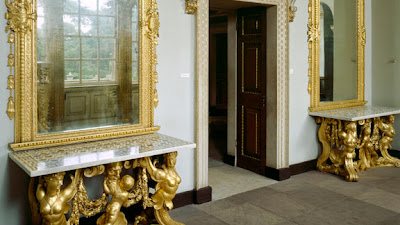
So now let's look at William Kent, the 18th c. British painter, interior designer, and architect who was a major figure of Palladianism, a style that was based upon the designs of 16th c. Italian architect Andrea Palladio. Palladio's Classical architecture was strongly influenced by ancient Roman architecture and art. It was this Classicism and its motifs of shells, masks, and pediments that form the basis of Palladian design. In fact, if you look back at yesterday's photos of Kent style tables, you'll see these motifs featured prominently.
Kent's career shifted from painting to interiors and architecture after meeting Lord Burlington, one of the major champions of this British Classical style. It was Burlington who hired Kent to decorate both Chiswick House, Burlington's Palladian style villa outside of London, as well as his home in London, Burlington House. Under Burlington's patronage, Kent went on to design the exteriors and interiors of such houses as Kensington Palace, Houghton Hall, and Holkham Hall.
One aspect of Palladian design that I find so interesting is that while the exteriors of these Palladian homes reflected the restraint of classical architecture, the interiors tended to be ornately and richly decorated. Perhaps this is why I am so taken with Kent style tables and their elaborate carvings and reliefs. The ultimate might be to live in a house like that at 44 Berkeley Square, London, in which Kent served as architect. Barring that, though, I'd be just as happy owning anything in the style of William Kent.
A cabinet designed by William Kent and Horace Walpole, 1743, rosewood and ivory. The ivory medallions were collected by Walpole during his Grand Tour in Italy and France around 1740. (Collection of Victoria & Albert Museum)
The Long Library at Holkham Hall, designed by Kent.
One of the state bedrooms at Houghton Hall that still retains the original furnishings and decoration by Kent.

Another state bedroom at Houghton Hall, this one with Kent's famous green velvet bed that features a shell over the bed's head.
An illustration of Chiswick House, the Palladian villa of Lord Burlington.
A gilt pinewood and marble console table designed by Kent for Chiswick House, c. 1730. (Collection of Victoria & Albert Museum)
This pair of tables at Chiswick House were designed by Kent for Lord Burlington.
The ornate double staircase at 44 Berkeley Square, London. Kent was the architect of this house that was built in 1742.
Portrait at top of William Kent, William Aikman painter, c. 1723-25, collection of the National Portrait Gallery.
Thursday, November 18, 2010
A William Kent Primer
Subscribe to:
Post Comments (Atom)







One of the most amazing staircases ever! I understand there is a resident ghost seen on it fairly regularly...it would be hard to leave.
ReplyDeleteLove ALL of this - such a glorious period. And I was going to mention the table in Alexa Hampton's office but = I see you wrote about it yesterday - perfect!! Also, there is a wonderful Palladio show in Washington, DC right now at the National Building Museum - there are some terrific videos on their site.
ReplyDeleteI love George II and William Kent, in particular. Anything truly classical with that amazing attention to detail makes me happy. Thanks for the tutorial--I needed this refresher course.
ReplyDeleteLovely post, Madame Peak!
ReplyDeleteIn the last book written by John Cornforth before his
death, there's a hefty chapter devoted to William Kent
who seems to be one of those slightly elusive characters in design history, famous though his name
and his architecture are.
The staircase at 44 Berkeley Square is flat out brilliant.
While I am against primogeniture, it brought us some of the most spectacular houses and estates in history.
ReplyDeleteBest,
Liz
I have not visited Chiswick since the restoration with wallcoverings and some furnishings added, but I am a big William Kent fan.
ReplyDeleteI love Kent - especially his architecture...all the British architects are fascinating!
ReplyDelete